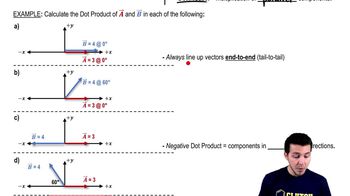Introduction to Dot Product (Scalar Product) definitions Flashcards
 Back
BackIntroduction to Dot Product (Scalar Product) definitions
1/15
Terms in this set (15)
- Dot ProductA scalar result from multiplying two vectors, calculated as the product of their magnitudes and the cosine of the angle between them.
- ScalarA quantity with magnitude but no direction, often resulting from the dot product of vectors.
- MagnitudeThe length or size of a vector, denoted by absolute value signs in calculations.
- CosineA trigonometric function that determines the dot product's value based on the angle between vectors.
- Parallel ComponentsParts of vectors that align in the same direction, crucial for calculating the dot product.
- PerpendicularVectors at a 90-degree angle to each other, resulting in a dot product of zero.
- Anti-parallelVectors pointing in opposite directions, yielding a negative dot product.
- AngleThe smallest angle between two vectors, used in the dot product formula.
- Degrees ModeA calculator setting required for accurate trigonometric calculations in the dot product.
- Vector MultiplicationThe process of multiplying vectors, which can result in a scalar or vector, depending on the method.
- Cross ProductA vector multiplication method resulting in a vector, not covered in detail here.
- NotationSymbols used to represent mathematical operations, such as a dot for the dot product.
- Tail to TailA method of aligning vectors for calculating the dot product, ensuring they start at the same point.
- Right AngleAn angle of 90 degrees, indicating perpendicular vectors with a dot product of zero.
- Negative SignIndicates opposite directions in vector components, resulting in a negative dot product.

